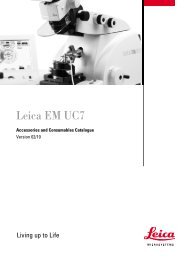Physical Principles of Electron Microscopy: An Introduction to TEM ...
Physical Principles of Electron Microscopy: An Introduction to TEM ...
Physical Principles of Electron Microscopy: An Introduction to TEM ...
You also want an ePaper? Increase the reach of your titles
YUMPU automatically turns print PDFs into web optimized ePapers that Google loves.
<strong>Electron</strong> Optics 41<br />
2.4 Focusing Properties <strong>of</strong> a Thin Magnetic Lens<br />
The use <strong>of</strong> ferromagnetic polepieces results in a focusing field that extends<br />
only a few millimeters along the optic axis, so that <strong>to</strong> a first approximation<br />
the lens may be considered thin. Deflection <strong>of</strong> the electron trajec<strong>to</strong>ry can<br />
then be considered <strong>to</strong> take place at a single plane (the principal plane), which<br />
allows thin-lens formulas such as Eq. (2.2) and Eq. (2.3) <strong>to</strong> be used <strong>to</strong><br />
describe the optical properties <strong>of</strong> the lens.<br />
The thin-lens approximation also simplifies analysis <strong>of</strong> the effect <strong>of</strong> the<br />
magnetic forces acting on a charged particle, leading <strong>to</strong> a simple expression<br />
for the focusing power (reciprocal <strong>of</strong> focal length) <strong>of</strong> a magnetic lens:<br />
1/f = [e 2 /(8mE0)] � Bz 2 dz (2.7)<br />
As we are considering electrons, the particle charge e is 1.6 �10 -19 C and<br />
mass m = 9.11 � 10 -31 kg; E0 represents the kinetic energy <strong>of</strong> the particles<br />
passing through the lens, expressed in Joule, and given by E0 = (e)(V0) where<br />
V0 is the potential difference used <strong>to</strong> accelerate the electrons from rest. The<br />
integral ( � Bz 2 dz ) can be interpreted as the <strong>to</strong>tal area under a graph <strong>of</strong> Bz 2<br />
plotted against distance z along the optic axis, Bz being the z-component <strong>of</strong><br />
magnetic field (in Tesla). Because the field is non-uniform, Bz is a function<br />
<strong>of</strong> z and also depends on the lens current and the polepiece geometry.<br />
There are two simple cases in which the integral in Eq. (2.7) can be<br />
solved analytically. One <strong>of</strong> these corresponds <strong>to</strong> the assumption that Bz has a<br />
constant value B0 in a region –a < z < a but falls abruptly <strong>to</strong> zero outside this<br />
region. The <strong>to</strong>tal area is then that <strong>of</strong> a rectangle and the integral becomes<br />
2aB0 2 . This rectangular distribution is unphysical but would approximate the<br />
field produced by a long solenoid <strong>of</strong> length 2a.<br />
For a typical electron lens, a more realistic assumption is that B increases<br />
smoothly <strong>to</strong>ward its maximum value B0 (at the center <strong>of</strong> the lens) according<br />
<strong>to</strong> a symmetric bell-shaped curve described by the Lorentzian function:<br />
Bz = B0 /(1 + z 2 /a 2 ) (2.8)<br />
As we can see by substituting z = a in Eq. (2.8), a is the half-width at half<br />
maximum (HWHM) <strong>of</strong> a graph <strong>of</strong> Bz versus z , meaning the distance (away<br />
from the central maximum) at which Bz falls <strong>to</strong> half <strong>of</strong> its maximum value;<br />
see Fig. 2-8. Alternatively, 2a is the full width at half maximum (FWHM) <strong>of</strong><br />
the field: the length (along the optic axis) over which the field exceeds B0/2.<br />
If Eq. (2.8) is valid, the integral in Eq. (2.7) becomes (�/2)aB0 2 and the<br />
focusing power <strong>of</strong> the lens is<br />
1/f = (�/16) [e 2 /(mE0)] aB0 2<br />
(2.9)



